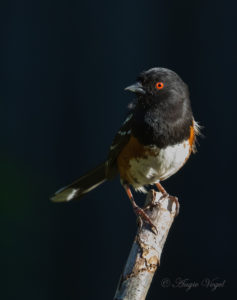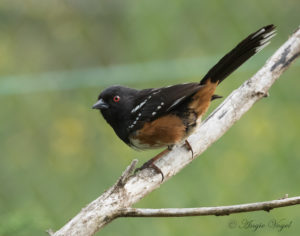 The Spotted Towhee is a large, handsome sparrow, often heard before seen, hopping about in the dry brush. They can be difficult to spot among the dry brown leaves; your best bet to catch a glimpse of this beauty is to walk slowly along the edge of a forest, brushy edges or undergrowth. Listen for it’s cat-like mewing call or rapid, buzzy song. The Spotted Towhee lives in the Northwest year-round, so there are plenty of chances to get out, visit the Refuge, catch a glimpse, and enjoy all that nature has to offer.
The Spotted Towhee is a large, handsome sparrow, often heard before seen, hopping about in the dry brush. They can be difficult to spot among the dry brown leaves; your best bet to catch a glimpse of this beauty is to walk slowly along the edge of a forest, brushy edges or undergrowth. Listen for it’s cat-like mewing call or rapid, buzzy song. The Spotted Towhee lives in the Northwest year-round, so there are plenty of chances to get out, visit the Refuge, catch a glimpse, and enjoy all that nature has to offer.
You might also spot one of these fascinating birds in your very own yard if there’s an abundance of brush, shrubs or overgrown borders. If you have bird feeders close to a border of greenery, a towhee may venture out into the open to eat fallen seed.
The male Spotted Towhee has distinctive, deep chestnut flanks and sides, solid black head, brilliant red eyes, and a white belly; its named for the white spots on its wings. Females are more brown in color. Towhees in Eastern Washington have heavier spotting than their western counterparts, with larger spots and whiter tails.
Spotted Towhees forage mainly in thick layers of leaf litter and heavy foliage on the ground. They hop around nosily on the ground with deliberate movements, scratching at leaves with their characteristic two-footed backward hop, pouncing on any prey they expose.
Spotted Towhees occasionally sun themselves, lying down on the grass with feathers spread.
These birds are primarily seed eaters, but during breeding season they dine on insects, including beetles, ladybugs, crickets, grasshoppers and  even bees, wasps and spiders. In the fall months, their diet mainly consists of acorns, berries, and seeds, and crops such as oats, wheat or corn.
even bees, wasps and spiders. In the fall months, their diet mainly consists of acorns, berries, and seeds, and crops such as oats, wheat or corn.
Males and females pair up together as early as February. In April, the female selects a site for the nest in a concealed location at or near ground level. They are creative nest-builders, building the nest into the leaf litter, with the rim of the nest even with the litter surface. The nest is made of bark, grass, leaves, pine needles and similar material.
The female will lay between 3-5 eggs, incubating them for about two weeks. Once hatched, both parents feed the young. Mom and dad continue to feed the young, which stay in their parents’ territory for about 30 days after they leave the nest. Usually one or two broods each season.
Spotted Towhees vary in their migration patterns. Those in western Washington birds are year-round residents. Most birds in eastern Washington leave for wintering grounds in the western and southwestern U.S.
COOL FACTS-
The signature towhee two-footed, backwards-scratching hop is used by a number of towhee and sparrow species to uncover the seeds and insects they feed on. One Spotted Towhee with an unusable, injured foot was observed hopping and scratching with one foot.
The Spotted Towhee and the very similar Eastern Towhee used to be members of the same species, the Rufous-sided Towhee. This is a common evolutionary pattern in North American birds, a holdover from when the great ice sheets split the continent in half, isolating birds into eastern and western populations that eventually evolve to become new species.
Early in the breeding season, male Spotted Towhees spend their mornings singing, singing, and singing some more, in an attempt to attract a female. Males can spend 70–90% of their time in the mornings singing. As soon as they’ve attracted a mate, they tire of singing and only spend about 5% of their time in song.
The oldest recorded Spotted Towhee was a male, and at least 11 years old when he was caught during banding exercises in California.
Photos: Angie Vogel